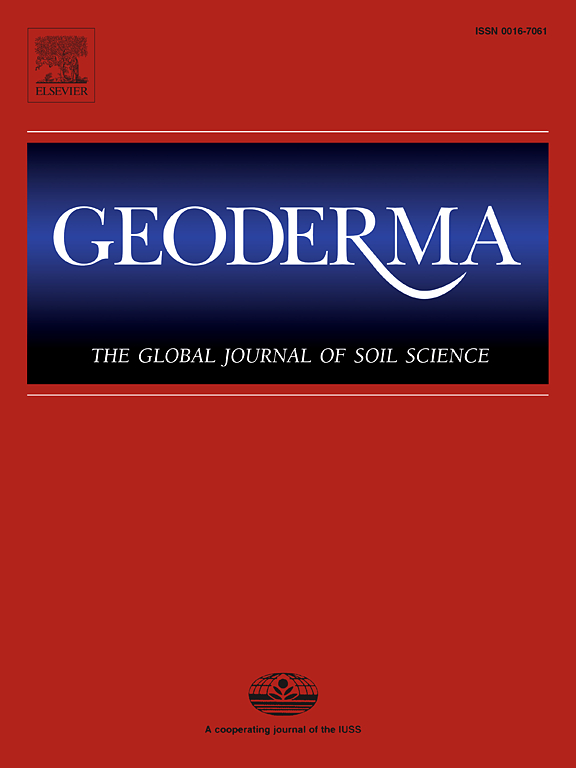肥料衍生有机氮组分在耕地土壤中的内部转化与玉米秸秆覆盖的调控
IF 6.6
1区 农林科学
Q1 SOIL SCIENCE
引用次数: 0
摘要
土壤有机氮(SON)是土壤中主要的残肥氮(N)库,影响土壤N的保持和供应能力。然而,由于氮素组分的来源和组成不同,残肥N的内部转化与特定氮素组分的关系以及玉米秸秆覆盖的影响尚不清楚。因此,通过15n标记技术和SON分数分析,我们在9年的试验中跟踪了肥料N分配到SON分数的情况,有和没有玉米秸秆覆盖。活性水解氮素(HN)组分的氮素留存率(占施氮量的24.7 ~ 26.6%)高于酸不溶性氮素(NHN)组分(占施氮量的1.2 ~ 1.9%),且到第9年,活性水解氮素(HN)组分的氮素下降速度更快(占施氮量的5.5 ~ 8.7%)。因此,HN是肥料N残留效应的储存库,HN和NHN组分对土壤中N的长期滞留都有贡献。在HN组分中,肥料N在水解铵态氮(HAN)和水解未知态氮(HUN)中富集和快速释放,表明HAN和HUN是两个快速周转库。然而,微生物组分,如氨基糖氮(ASN)和氨基酸氮(AAN),对肥料氮的稳定至关重要。我们的研究揭示了不同水解SON组分之间的内部循环,水解SON组分主要通过HUN实现功能互补。从长期氮肥转化的角度看,玉米秸秆覆盖可以增强土壤中SON组分(ASN、AAN、HAN、HUN和NHN)的特异功能,最终提高土壤中氮肥的保留率(从施肥量的6.9%提高到9.2 ~ 10.9%)。本研究为研究氮素在玉米籽粒氮素组分中的转化及其对玉米秸秆覆盖的响应提供了一个创新的视角。本文章由计算机程序翻译,如有差异,请以英文原文为准。
Internal transformation of fertilizer-derived organic nitrogen fractions in an arable soil and the regulation of maize residue mulching
Soil organic nitrogen (SON) is a major residual fertilizer nitrogen (N) reservoir in soil and affects soil N retention and supply capacity. However, owing to the diverse origins and compositions of SON fractions, the internal transformation of residual fertilizer N associated with specific SON fractions and the influence of maize residue mulching remain unclear. Thus, via the 15N-labelling technique and SON fraction analysis, we tracked fertilizer N allocation into SON fractions over a 9-year trial, with and without maize residue mulching. Fertilizer N was initially retained more in active hydrolysable N (HN) fractions (24.7–26.6 % of applied N) than in acid insoluble N (NHN) fractions (1.2–1.9 % of applied N), and decreased more rapidly in HN by the 9th year (5.5–8.7 % of applied N). Therefore, the HN served as a reservoir with residual effects of fertilizer N and both the HN and NHN fractions contributed to long-term N retention in the soil. Among the HN fractions, the high enrichment and rapid release of fertilizer N in hydrolysable ammonium N (HAN) and hydrolysable unknown N (HUN) indicated that HAN and HUN were the two fast turnover pools. However, microbial fractions, such as amino sugar N (ASN) and amino acid N (AAN), were crucial for fertilizer N stabilization. Our study revealed internal cycling among the different hydrolysable SON fractions, and hydrolysable SON fractions primarily achieved functional complementarity through HUN. Maize residue mulching could enhance the specific functions of SON fractions (ASN, AAN, HAN, HUN and NHN) from the perspective of long-term fertilizer N transformation, which eventually improved fertilizer N retention in the soil (from 6.9 % to 9.2–10.9 % of applied fertilizer N). This investigation provides an innovative perspective on N nutrient management through fertilizer N transformation in SON fractions and the response to maize residue mulching.
求助全文
通过发布文献求助,成功后即可免费获取论文全文。
去求助
来源期刊

Geoderma
农林科学-土壤科学
CiteScore
11.80
自引率
6.60%
发文量
597
审稿时长
58 days
期刊介绍:
Geoderma - the global journal of soil science - welcomes authors, readers and soil research from all parts of the world, encourages worldwide soil studies, and embraces all aspects of soil science and its associated pedagogy. The journal particularly welcomes interdisciplinary work focusing on dynamic soil processes and functions across space and time.
 求助内容:
求助内容: 应助结果提醒方式:
应助结果提醒方式:


